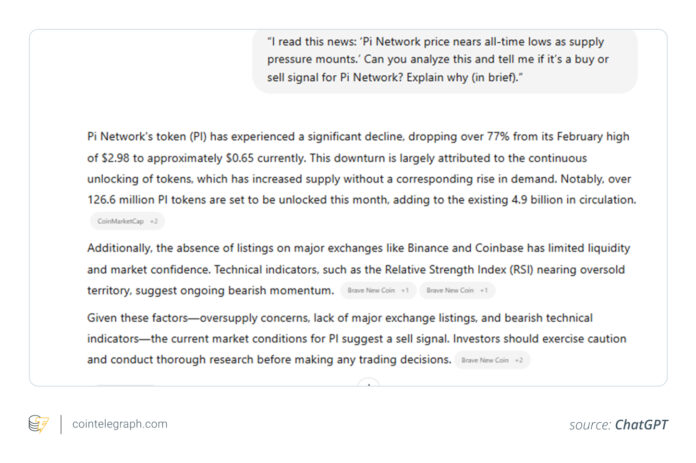Unlocking the Power of ChatGPT: Converting Crypto News into Trade Signals
The cryptocurrency market is known for its volatility and rapid price movements, making it challenging for traders to stay ahead of the curve. News plays a significant role in driving crypto prices, but sifting through the noise to identify actionable trade signals can be overwhelming, especially for beginners. This is where ChatGPT, a powerful AI tool, comes into play. In this article, we will explore how to use ChatGPT to analyze crypto news and generate trade signals, providing traders with a valuable edge in the market.
Understanding Trading Signals
Before diving into the world of ChatGPT, it’s essential to understand what a trading signal is. A trading signal is a suggestion to buy or sell a cryptocurrency based on specific information, such as price trends, market sentiment, or recent news. For example, if a coin’s price drops due to increased supply, this could be a “buy” signal if you believe it’s undervalued or a “sell” signal if you expect further declines. The goal is to use ChatGPT to help identify these signals from the news.
Step 1: Collecting Crypto News
To get started, you’ll need some crypto news to analyze. You can find this on crypto media websites, social media platforms, or news aggregators like Google News or Feedly, using keywords like “cryptocurrency” or “blockchain.” Suppose you come across the headline: “Pi Network price nears all-time lows as supply pressure increases.” This is where you can begin to apply ChatGPT’s capabilities.
Step 2: Utilizing ChatGPT
With your news article in hand, the next step is to open ChatGPT and enter your questions or requests into the chat interface. You can log in to the OpenAI website and start exploring how ChatGPT can analyze the news and provide insights.
Step 3: Crafting a Simple Command Prompt
A “prompt” is a clear instruction you give the AI. For beginners, it’s best to keep it simple and specific. Tell ChatGPT what news you have and what you want to achieve with it. Using the Pi Network headline as an example, your prompt could be: “I read this message: ‘Pi Network price nears all-time lows as supply pressure increases.’ Can you analyze this and tell me if it is a buy or sell signal for Pi Network? Briefly explain why.”
ChatGPT’s response will parse the message, suggesting a sell signal and citing the unlocking of 126.6 million PI tokens as a bearish factor that will likely push the price lower due to weak demand. It may also recommend caution and further research, highlighting the importance of considering multiple factors before making a trade.
Step 4: Asking More Questions
The first answer may not cover everything. You can dive deeper with follow-up questions like: “What are the risks of buying Pi Network at its all-time low?” or “How does the unlocking of tokens affect the price?” These questions can help you understand the potential downsides and the impact of specific events on the market.
ChatGPT’s responses to these follow-up questions will provide more detailed insights, such as the risks of buying at an all-time low, including increasing supply and downward pressure, persistent bearish momentum, low liquidity, and limited real-world utility. This information is crucial for making informed decisions.
Step 5: Combining News with Market Context
News does not exist in a vacuum. You could ask ChatGPT to consider broader market trends, such as the performance of Bitcoin or the momentum of altcoins. For example: “Given this news from Pi Network, how should I trade when Bitcoin is booming? Keep your answer short.” This helps you understand how different market factors interact and influence each other.
ChatGPT’s response might advise against buying Pi Network despite the rise in Bitcoin, citing weak momentum and oversupply as reasons to focus on stronger assets. It may also recommend waiting for improvements in demand or market indicators before considering a purchase.
Step 6: Testing and Refining
AI is not perfect; it’s a tool, not a crystal ball. Testing ChatGPT’s suggestions with small trades or paper trading (simulated trades without real money) and adjusting your prompts over time for better results is essential. This iterative process helps refine your strategy and improve the accuracy of the signals generated by ChatGPT.
Risks and Considerations
While ChatGPT can be a powerful tool for generating trade signals, it’s crucial to understand the risks involved. Market volatility, overconfidence in AI, technical problems, limited scope of analysis, and security risks are all potential pitfalls. Always validating AI findings against other research, charts, and risk management practices before executing trades is vital.
Tips for Success
To get the most out of ChatGPT’s trading insights while minimizing risks, several best practices can be followed. Being specific with your prompts, counterchecking AI analysis with other sources, staying up to date with the latest news, managing risk, starting small, diversifying signals, setting stop losses, and staying informed about market trends are all key strategies for successful trading with ChatGPT.
Conclusion
In conclusion, ChatGPT offers a unique opportunity for traders to analyze crypto news and generate actionable trade signals. By following the steps outlined in this article and being mindful of the risks and considerations, traders can leverage ChatGPT to make more informed decisions. Remember, ChatGPT is a tool, not a financial advisor, and its signals should be used as part of a broader trading strategy that includes thorough research and risk management. For more information on how to use ChatGPT for crypto trading and to stay updated on the latest developments in the cryptocurrency market, visit https://cointelegraph.com/news/how-to-use-chatgpt-to-turn-crypto-news-into-trade-signals?utm_source=rss_feed&utm_medium=rss_category_analysis&utm_campaign=rss_partner_inbound.

